- All organisms are composed of cells.
- Unicellular - composed of a single cell and are called unicellular organisms.
- Multicellular - composed of many cells, are called multicellular organisms.
- Robert Hooke - discovered a cell. (dead)
- Anton Von Leeuwenhoek - first discovered a live cell.
- Robert Brown - discovered the nucleus
What is a cell ?
- (i) independent existence
- (ii) Performing the essential functions of life.
- Anything less than a complete structure of a cell does not ensure independent living.
CELL THEORY
- Matthias Schleiden (1838) - a German botanist, examined a large number of plants and observed that all plants are composed of different kinds of cells which form the tissues of the plant.
- Theodore Schwann (1839) - a British Zoologist, studied different types of animal cells and reported that cells had a thin outer layer which is today known as the ‘plasma membrane’.
- The presence of cell wall is a unique character of the plant cells.
- Schwann proposed the hypothesis that the bodies of animals and plants are composed of cells and products of cells.
☆ Schleiden and Schwann together formulated the cell theory.
- Drawback = did not explain as to how new cells were formed.
- Rudolf Virchow (1855) - first explained that cells divided and new cells are formed from pre- existing cells (Omnis cellula-e cellula). (NEET 2019)
- Cell theory as understood today is:
- (I) all living organisms are composed of cells and products of cells.
- (II) all cells arise from pre-existing cells.
An Overview of Cell

- In Plant Cell - Cell wall (outer) Cell membrane (inside the cell wall)
- In Animal cell - Cell membrane (outer)
- Nucleus - contain the chromosomes which in turn contain the genetic material, DNA.
- Eukaryote - Cells that have membrane bound nucleus.
- Prokaryote - cells that lack a membrane bound nucleus.
- Cytoplasm - a semi-fluid matrix called cytoplasm occupies the volume of the cell.
- It is main arena of cellular activities in both the plant and animal cells. (NEET 2010,2015)
- Various chemical reactions occur in it to keep the cell in the ‘living state’
- It is present in both Prokaryotes and eukaryotes.
• Cell Organelles - the eukaryotic cells have other membrane bound distinct structures called organelles like the endoplasmic reticulum (ER), the golgi complex, lysosomes, mitochondria, microbodies and vacuoles.
- prokaryotic cells lack such membrane bound organelles.(NEET 2015,2016)
• Ribosomes - non-membrane bound organelles found in all cells – both eukaryotic as well as prokaryotic.
- Ribosomes are found not only in the cytoplasm but also within the two organelles – chloroplasts (in plants) and mitochondria and on rough ER. (NEET 2015)
- Centrosome - Animal cells contain another non-membrane bound organelle called centrosome which helps in cell division.
- Size and Shapes of Cells
- Mycoplasmas, the smallest cells, are only 0.3 µm in length.
- Bacteria could be 3 to 5 µm.
- Largest isolated single cell is the egg of an ostrich. Among multicellular organisms.
- Human Red blood cells are about 7.0 µm in diameter.
- Nerve cells are some of the longest cells.
- Shape - may be disc-like, polygonal, columnar, cuboid, thread like, or even irregular.
- Shape of the cell may vary with the function they perform.
Prokaryotic Cell
- Represented by bacteria, blue-green algae, mycoplasma and PPLO (Pleuro Pneumonia Like Organisms).
- Generally smaller and multiply more rapidly than the eukaryotic cells.
- Shape - four basic shapes of bacteria are bacillus (rod like), coccus (spherical), vibrio (comma shaped) and spirillum (spiral).
- prokaryotes exhibit a wide variety of shapes and functions.
- All prokaryotes have a cell wall surrounding the cell membrane except in mycoplasma.
- No well-defined nucleus ( genetic material is basically naked, not enveloped by a nuclear membrane).
- Genomic DNA (the single chromosome/circular DNA), many bacteria have small circular DNA outside the genomic DNA which are called plasmids.
- Plasmid DNA confers certain unique phenotypic characters to such bacteria. Ex. character is resistance to antibiotics.
- Plasmid DNA is used to monitor bacterial transformation with foreign DNA.
- No organelles, like the ones in eukaryotes, are found in prokaryotic cells except for ribosomes.
- Differentiated form of cell membrane called mesosome is the characteristic of prokaryotes essentially infoldings of cell membrane.

▪ Cell Envelope and its Modifications
- Bacterial cells, have a chemically complex cell envelope.
- Cell envelope consists of a tightly bound three layered structure
i. The outermost glycocalyx
ii. Middle the cell wall
iii. Inner the plasma membrane.
- Each layer of the envelope performs distinct function, they act together as a single protective unit.
- Bacteria can be classified into two groups on the basis of the differences in the cell envelopes and the manner in which they respond to the staining procedure developed by Gram.
- those that take up the gram stain are Gram positive
- that do not are called Gram negative bacteria.
i. Glycocalyx - differs in composition and thickness among different bacteria.
- Glycocalyx could be a loose sheath called the slime layer in some.
- in others it may be thick and tough, called the capsule.
- It also gives sticky surface to the cell for adhesive. (NEET 2017)
- Cell wall - determines the shape of the cell and provides a strong structural support to prevent the bacterium from bursting or collapsing.
- Pasma membrane - is selectively permeable in nature and interacts with the outside world.
This membrane is similar structurally to that of the eukaryotes.
- A special membranous structure is the mesosome which is formed by the extensions of plasma membrane into the cell.
- These extensions are in the form of vesicles, tubules and lamellae.
- They help in cell wall formation, DNA replication and distribution to daughter cells, in respiration, secretion processes, to increase the surface area of the plasma membrane and enzymatic content.
- In some prokaryotes like cyanobacteria, there are other membranous extensions into the cytoplasm called chromatophores which contain pigments.
• Bacterial cells may be motile or non-motile.
- If motile, they have thin filamentous extensions from their cell wall called flagella and show a range in the number and arrangement of flagella.
- Bacterial flagellum is composed of three parts –
i. filament ii. hook iii. basal body.
i. Flament is the longest portion and extends from the cell surface to the outside.
- Pili and Fimbriae are also surface structures of the bacteria but do not play a role in motility. (NEET 2016)
- Pili are elongated tubular structures made of a special protein.
- Fimbriae are small bristle like fibres sprouting out of the cell.
- In some bacteria pili and fimbriae are known to help attach the bacteria to rocks in streams and also to the host tissues.
Ribosomes and Inclusion Bodies

In prokaryotes, ribosomes are associated with the plasma membrane of the cell.
- about 15 nm by 20 nm in size and are made of two subunits - 50S and 30S units which when present together form 70S prokaryotic ribosomes.
- Ribosomes are the site of protein synthesis.
Several ribosomes may attach to a single mRNA and form a chain called polyribosomes or polysome. (NEET 2018)
Ribosomes of a polysome translate the mRNA into proteins.
Inclusion bodies: Reserve material in prokaryotic cells are stored in the cytoplasm in the form of inclusion bodies.
Not bound by any membrane system and lie free in the cytoplasm, e.g., phosphate granules, cyanophycean granules and glycogen granules.
Gas vacuoles are found in blue green and purple and green photosynthetic bacteria
EUKARYOTIC CELLS
- Include all the protists, plants, animals and fungi.
- An extensive compartmentalisation of cytoplasm through the presence of membrane bound organelles.
- An organised nucleus with a nuclear envelope.
- Cells have a variety of complex locomotory and cytoskeletal structures.
- Genetic material is organised into chromosomes.
- Plant Cells = possess cell walls, plastids and a large central vacuole which are absent in animal cells. (NEET 2016)
- Animal cells = centrioles which are absent in almost all plant cells.
Cell Membrane
Detailed structure of the membrane was studied only after the advent of the electron microscope in the 1950s.
- Chemical studies on the cell membrane, especially in human red blood cells (RBCs), enabled the scientists to deduce the possible structure of plasma membrane.
• Cell membrane is mainly composed of lipids and proteins also possess protein and carbohydrate. (Aipmt 2010)
- Ratio of protein and lipid varies considerably in different cell types.
- Human RBC membrane has approximately 52 per cent protein and 40 per cent lipids
- Major lipids are phospholipids that are arranged in a bilayer.
- lipids are arranged within the membrane with the polar head towards the outer sides and the hydrophobic tails towards the inner part which ensures that the nonpolar tail of saturated hydrocarbons is protected from the aqueous environment.
- Phospholipids membrane also contains cholesterol.
Depending on the ease of extraction, membrane proteins can be classified as
i. Integral protein ii. Peripheral protein
- Peripheral proteins lie on the surface of membrane.
- Integral proteins are partially or totally buried in the membrane.
• An improved model of the structure of cell membrane was proposed by Singer and Nicolson. (1972) widely accepted as fluid mosaic model. (Aipmt 2012)
the quasi-fluid nature of lipid enables lateral movement of proteins within the overall bilayer and provide ability to move within the membrane is measured as its fluidity.
- Fluid nature of the membrane is also important from the point of view of functions like cell growth, formation of intercellular junctions, secretion, endocytosis, cell division etc.
- Functions of the plasma membrane :-
- Transport of the molecules across it.
- Selectively permeable to some molecules present on either side of it.
Passive Transport./ Simple diffusion - Molecules can move briefly across the membrane without any requirement of energy.
Example - Neutral solutes and water along the
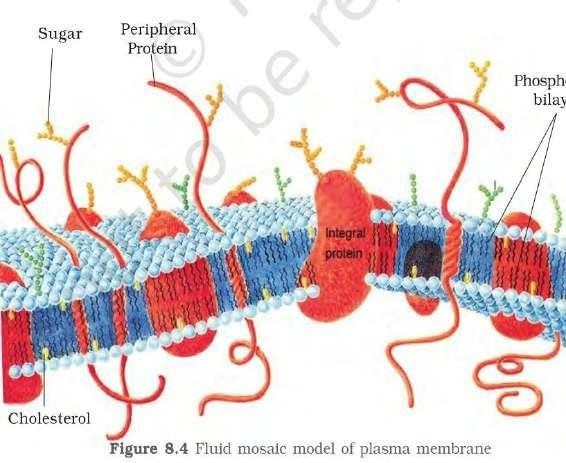
concentration gradient ( from higher concentration to the lower)
- Osmosis - Movement of water by diffusion is called osmosis.
- Facilitated transport - Polar molecules cannot pass through the nonpolar lipid bilayer, they require a carrier protein of the membrane to facilitate their transport across the membrane.
- Active transport - transported across the membrane against their concentration gradient (from lower to the higher concentration) is an energy dependent process, in which ATP is utilised and is called active transport
Example - A few ions or molecules and Na+/K+ pump .
Cell Wall
- A non-living rigid structure called the cell wall forms an outer covering for the plasma membrane of fungi and plants.
- Gives shape to the cell and protects the cell from mechanical damage and infection also helps in cell-to-cell interaction and provides barrier to undesirable macromolecules.
- Algae have cell wall, made of cellulose, galactans, mannans and minerals like calcium carbonate.
- Pants consists of cellulose, hemicellulose, pectins and proteins.
- Cell wall of a young plant cell, the primary wall is capable of growth, which gradually diminishes as the cell matures and the secondary wall is formed on the inner (towards membrane) side of the cell.
• Middle lamella is a layer mainly of calcium pectate which holds or glues the different neighbouring cells together.
Cell wall and middle lamellae may be traversed by plasmodesmata which connect the cytoplasm of neighbouring cells. (Aipmt 2009,2010)
Endomembrane System

The Endomembrane system include
1. Endoplasmic reticulum (ER) 2. Golgi complex
3. Lsosomes 4. Vacuoles.
The functions of the mitochondria, chloroplast and peroxisomes are not coordinated and are not considered as part of the endomembrane system.
1. Endoplasmic Reticulum (ER)
- Presence of a network or reticulum of tiny tubular structures scattered in the cytoplasm that is called the endoplasmic reticulum (ER).
- ER divides the intracellular space into two distinct compartments
i. Luminal (inside ER) ii. Extra luminal (cytoplasm)
Endoplasmic reticulun bearing ribosomes on their surface is called rough endoplasmic reticulum (RER). (Aipmt 2011)
- RER is frequently observed in the cells actively involved in protein synthesis and secretion.
- Extensive and continuous with the outer membrane of the nucleus.
- Absence of ribosomes they appear smooth and are called smooth endoplasmic reticulum (SER).
- SER is major site for synthesis of lipid. (NEET 2013,2018)
- Lipid-like steroidal hormones are synthesised in SER.
2. Golgi apparatus.
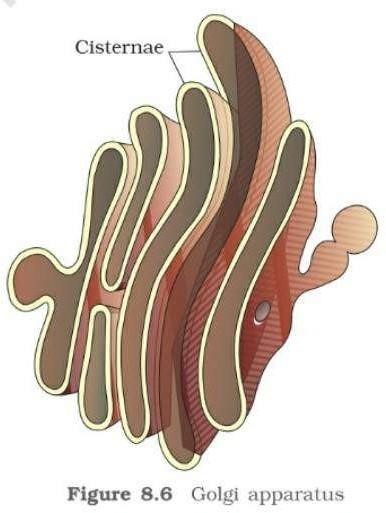
Camillo Golgi (1898) first observed densely stained reticular structures near the nucleus later named Golgi bodies after him.
- Consist of many flat, disc-shaped sacs or cisternae of 0.5µm to 1.0µm diameter are stacked parallel to each other. (NEET 2015)
- Varied number of cisternae are present in a Golgi complex.
- Golgi cisternae are concentrically arranged near the nucleus with distinct
- convex cis or the forming face
- concave trans or the maturing face.
- cis and the trans faces of the organelle are entirely different, but interconnected.
- golgi apparatus principally performs the function of packaging materials, to be delivered either to the intra-cellular targets or secreted outside the cell.
- Materials to be packaged in the form of vesicles from the ER fuse with the cis face of the golgi apparatus and move towards the maturing face. (NEET 2018)
- Golgi apparatus remains in close association with the endoplasmic reticulum.
- A number of proteins synthesised by ribosomes on the endoplasmic reticulum are modified in the cisternae of the golgi apparatus before they are released from its trans face.
• Golgi apparatus is the important site of formation of glycoproteins and glycolipids.(NEET 2011,2013)
3. Lysosomes
- Membrane bound vesicular structures formed by the process of packaging in the golgi apparatus.
- Isolated lysosomal vesicles have been found to be very rich in almost all types of hydrolytic enzymes (hydrolases – lipases, proteases, carbohydrases) optimally active at the acidic pH.
- Enzymes are capable of digesting carbohydrates, proteins, lipids and nucleic acids.
4. Vacuoles
- Membrane-bound space found in the cytoplasm.
- Contains water, sap, excretory product and other materials not useful for the cell. (NEET 2014)
- Vcuole is bound by a single membrane called tonoplast.
- Plant cells - vacuoles can occupy up to 90 per cent of the volume of the cell.
- tonoplast facilitates the transport of a number of ions and other materials against concentration gradients into the vacuole, hence their concentration is significantly higher in the vacuole than in the cytoplasm.
- In Amoeba the contractile vacuole is important for osmoregulation and excretion.
- In protists, food vacuoles are formed by engulfing the food particles.
Mitochondria
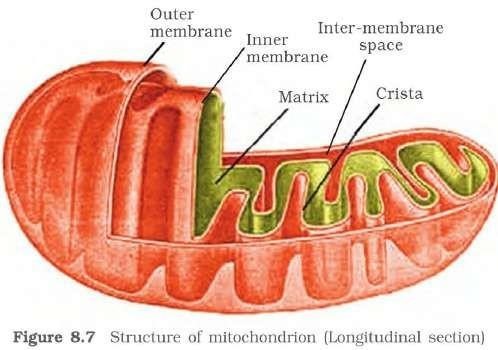
• Mitochondria (sing.: mitochondrion), unless specifically stained, are not easily visible under the microscope.
- Number of mitochondria per cell is variable depending on the physiological activity of the cells.
- Generally it is sausage-shaped or cylindrical having a diameter of 0.2-1.0µm (average 0.5µm) and length 1.0-4.1µm.
• Each mitochondrion is a double membrane-bound structure with the outer membrane and the inner membrane dividing its lumen distinctly into two aqueous compartments,
i. the outer compartment ii. the inner compartment.
- Inner compartment is filled with a dense homogeneous substance called the matrix.
- Outer membrane forms the continuous limiting boundary of the organelle.
- Inner membrane forms a number of infoldings called the cristae (sing.: crista) towards the matrix which increase the surface area. (NEET 2014,2015)
- Two membranes have their own specific enzymes associated with the mitochondrial function.
- Mitochondria are the sites of aerobic respiration which produce cellular energy in the form of ATP, hence they are called ‘power houses’ of the cell.
- Matrix also possesses single circular DNA molecule, a few RNA molecules, ribosomes (70S) and the components required for the synthesis of proteins.
- Mitochondria divide by fission. (NEET 2010,2016,2017,2019)
Plastids
- Found in all plant cells and in euglenoides.
- Easily observed under the microscope as they are large.
- Bear some specific pigments, thus imparting specific colours to the plants.
• Based on the type of pigments plastids can be classified into
(i) chloroplasts (ii) chromoplasts (iii) Leucoplasts.
(i) Chloroplasts contain chlorophyll and carotenoid pigments which are responsible for trapping light energy essential for photosynthesis.
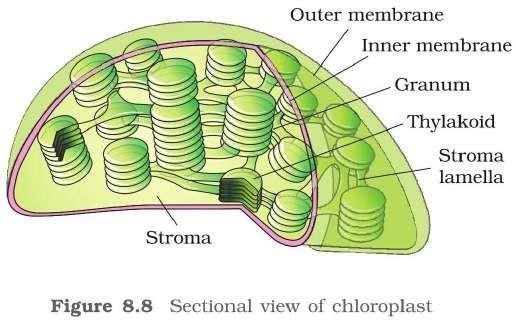
- Majority of the chloroplasts of the green plants are found in the mesophyll cells of the leaves.
- Shapes are lens-shaped, oval, spherical, discoid or even ribbon-like organelles having variable length (5-10µm) and width (2-4µm).
Number varies from 1 per cell of the Chlamydomonas, a green alga to 20-40 per cell in the mesophyll.
Chloroplasts are also double membrane bound.
- Inner chloroplast membrane is relatively less permeable.
- Space limited by the inner membrane of the chloroplast is called the stroma.
- A number of organised flattened membranous sacs called the thylakoids, are present in the stroma.
- Thylakoids are arranged in stacks like the piles of coins called grana (singular: granum) or the intergranal thylakoids. (NEET 2014,2015)
- Flat membranous tubules called the stroma lamellae connecting the thylakoids of the different grana.
- Membrane of the thylakoids enclose a space called a lumen.
- Stroma of the chloroplast contains enzymes required for the synthesis of carbohydrates and proteins.
- Contains small, double stranded circular DNA molecules and ribosomes.
- Chlorophyll pigments are present in the thylakoids. (NEET 2016,2019)
- Ribosomes of the chloroplasts are smaller (70S) than the cytoplasmic ribosomes (80S).
(ii) Chromoplasts fat soluble carotenoid pigments like carotene, xanthophylls and others are present. (NEET 2016)
- Gives the part of the plant a yellow, orange or red colour.
(iii) Leucoplasts are the colourless plastids of varied shapes and sizes with stored nutrients:
- Amyloplasts store carbohydrates (starch), e.g., potato;
- Elaioplasts store oils and fats
- Aleuroplasts store proteins.
Ribosomes
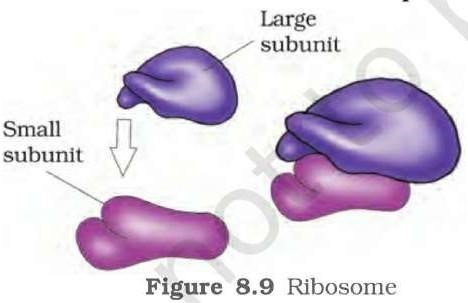
Ribosomes are the granular structures first observed under the electron microscope as dense particles by George Palade (1953).
- Composed of ribonucleic acid (RNA) and proteins and are not surrounded by any membrane. (NEET 2012)
- Eukaryotic ribosomes are 80S while the prokaryotic ribosomes are 70S.
- Ribosome has two subunits, larger and smaller subunits.
- Two subunits of 80S ribosomes are 60S and 40S.
- 70S ribosomes are 50S and 30S.
- ‘S’ (Svedberg’s Unit) stands for the sedimentation coefficient; it is indirectly a measure of density and size.
▪ Cytoskeleton
- An elaborate network of filamentous proteinaceous structures consisting of microtubules, microfilaments and intermediate filaments present in the cytoplasm is collectively referred to as the cytoskeleton. (Aipmt 2010)
- Functions such as mechanical support, motility, maintenance of the shape of the cell.
Cilia and Flagella
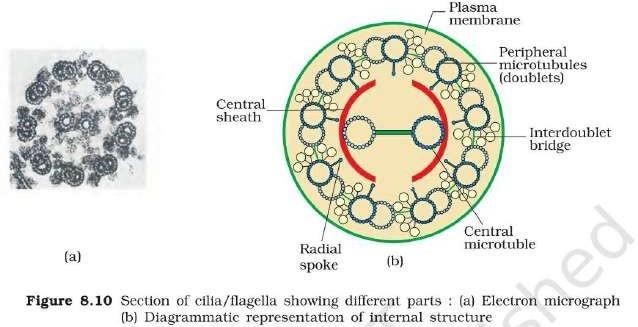
- Cilia (sing.: cilium) and flagella (sing.: flagellum) are hair-like outgrowths of the cell membrane.
- Cilia are small structures which work like oars, causing the movement of either the cell or the surrounding fluid.
- Flagella are comparatively longer and responsible for cell movement.
- Bacteria also possess flagella but these are structurally different from that of the eukaryotic flagella.
- Cilium or the flagellum are covered with plasma membrane.
- Core called the axoneme, possesses a number of microtubules running parallel to the long axis.
- Axoneme usually has nine doublets of radially arranged peripheral microtubules, and a pair of centrally located microtubules.
- Such an arrangement of axonemal microtubules is referred to as the 9+2 array.
- Central tubules are connected by bridges and is also enclosed by a central sheath, which is connected to one of the tubules of each peripheral doublets by a radial spoke.
- There are nine radial spokes and peripheral doublets are also interconnected by linkers.
- Both the cilium and flagellum emerge from centriole-like structure called the basal bodies. (NEET 2014)
Centrosome and Centrioles
- Centrosome is an organelle usually containing two cylindrical structures called centrioles.
- Surrounded by amorphous pericentriolar materials.
- Centrioles in a centrosome lie perpendicular to each other in which each has an organisation like the cartwheel.
- Made up of nine evenly spaced peripheral fibrils of tubulin protein and each of the peripheral fibril is a triplet.
- Adjacent triplets are also linked.
- Central part of the proximal region of the centriole is also proteinaceous and called the hub, which is connected with tubules of the peripheral triplets by radial spokes made of protein.
- Centrioles form the basal body of cilia or flagella, and spindle fibres that give rise to spindle apparatus during cell division in animal cells.
Nucleus
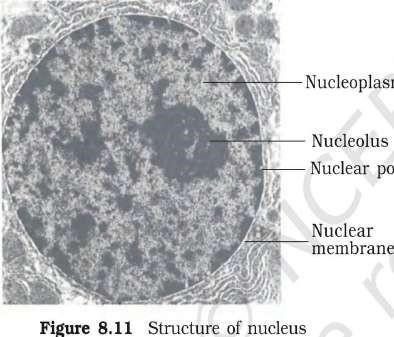
First described by Robert Brown as early as 1831.
- The interphase nucleus (nucleus of a cell when it is not dividing) has highly extended and elaborate nucleoprotein fibres called chromatin, nuclear matrix and one or more spherical bodies called nucleoli (sing.: nucleolus) (Figure 8.11).
- Nuclear envelope consists of two parallel membranes with a space between (10 to 50 nm) called the perinuclear space, forms a barrier between the materials present inside the nucleus and that of the cytoplasm.
- Outer membrane usually remains continuous with the endoplasmic reticulum and also bears ribosomes on it.
- Nuclear envelope is interrupted by minute pores, which are formed by the fusion of its two membranes.
- Nuclear pores are the passages through which movement of RNA and protein molecules takes place in both directions between the nucleus and the cytoplasm.
- Mostly one nucleus per cell, variations in the number of nuclei are also frequently observed.
- Some mature cells even lack nucleus, e.g., erythrocytes of many mammals and sieve tube cells of vascular plants.
- Nuclear matrix or the nucleoplasm contains nucleolus and chromatin.
- Nucleoli are spherical structures present in the nucleoplasm.
- Name chromatin by Flemming.
Nucleolus is continuous with the rest of the nucleoplasm as it is not a membrane bound structure and a site for active ribosomal RNA synthesis. (NEET 2012,2018)
Larger and more numerous nucleoli are present in cells actively carrying out protein synthesis.
Chromatin - Interphase nucleus has a loose and indistinct network of nucleoprotein fibres.
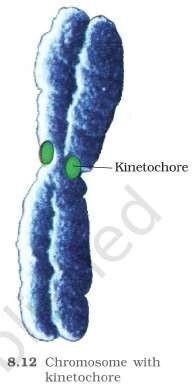
- Chromatin contains DNA and some basic proteins called histones, some non-histone proteins and also RNA.
- Single human cell has approximately two metre long thread of DNA distributed among its forty six (twenty three pairs) chromosomes.
- Chromosome (visible only in dividing cells) essentially has a primary constriction or the centromere on the sides of which disc shaped structures called kinetochores are present.
- Centromere holds two chromatids of a chromosome.
- Based on the position of the centromere, the chromosomes can be classified into four types
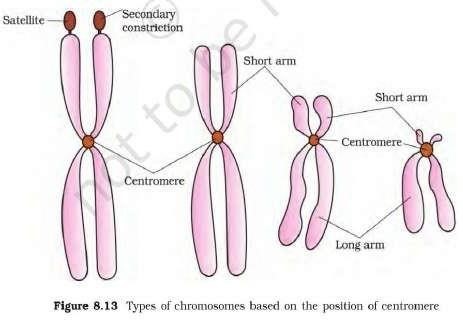
- Metacentric - chromosome has middle centromere forming two equal arms of the chromosome.
2. Sub-metacentric - chromosome has centromere slightly away from the middle of the chromosome resulting into one shorter arm and one longer arm.
Short arm is called p arm (p denote petite means short) and long arm called q arm and it look like L - shape.
- Bivalent of diplotene is called lambrush chromosomes.
- Sex determines chromosomes are known as Allosome. (NEET 2018,2019)
- Acrocentric - chromosome the centromere is situated close to its end forming one extremely short and one very long arm.
- Telocentric - chromosome has a terminal centromere.
• Few chromosomes have non-staining secondary constrictions at a constant location which gives the appearance of a small fragment called the satellite.
Microbodies
Many membrane bound minute vesicles called microbodies that contain various enzymes, are present in both plant and animal cells.

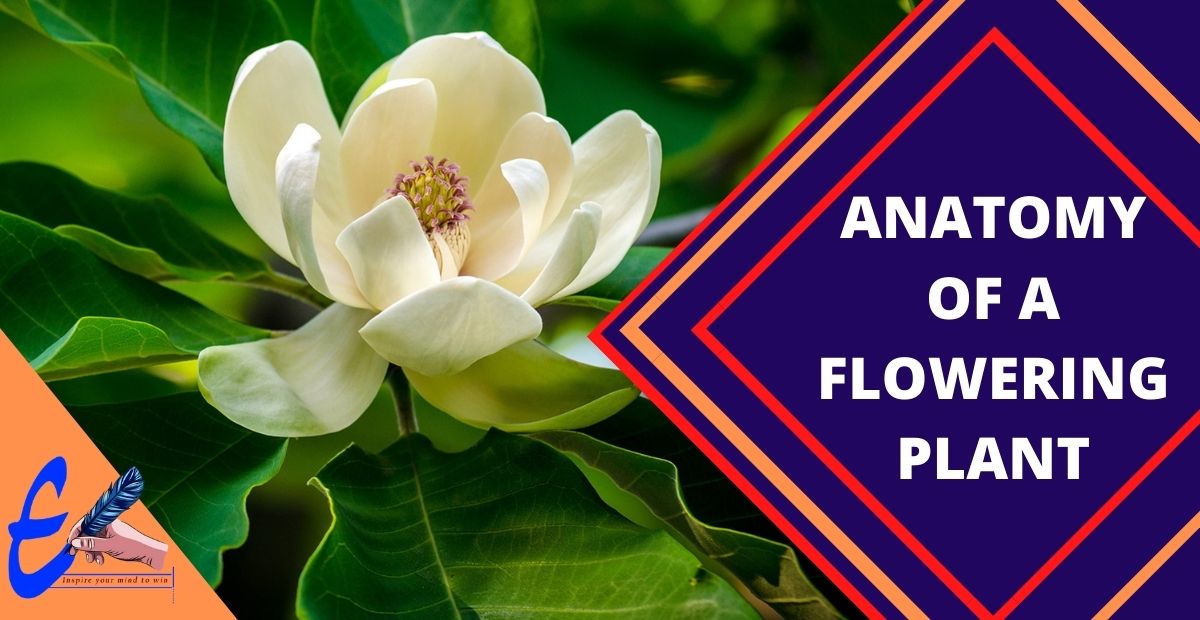
… [Trackback]
[…] Find More Info here to that Topic: eklabhyaclasses.com/blog/cell-the-unit-of-life/ […]
… [Trackback]
[…] There you will find 67042 more Info to that Topic: eklabhyaclasses.com/blog/cell-the-unit-of-life/ […]
… [Trackback]
[…] Here you will find 64738 more Info on that Topic: eklabhyaclasses.com/blog/cell-the-unit-of-life/ […]
… [Trackback]
[…] There you can find 16646 more Info to that Topic: eklabhyaclasses.com/blog/cell-the-unit-of-life/ […]
… [Trackback]
[…] Find More Information here on that Topic: eklabhyaclasses.com/blog/cell-the-unit-of-life/ […]
… [Trackback]
[…] Find More Information here to that Topic: eklabhyaclasses.com/blog/cell-the-unit-of-life/ […]
… [Trackback]
[…] Find More here to that Topic: eklabhyaclasses.com/blog/cell-the-unit-of-life/ […]